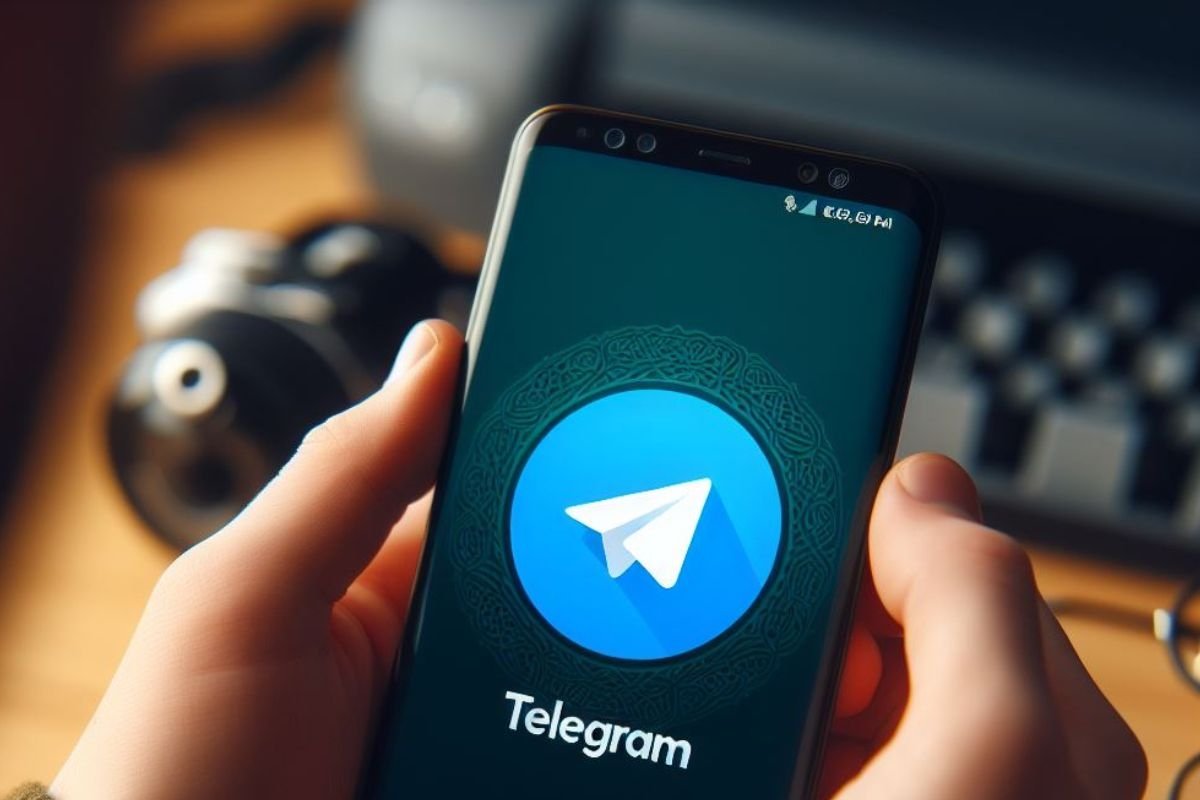In this guide, we will explain in detail what Telegram is and how it works. We will also show you some information regarding the beginnings of this platform, its main functions, and how to take your first steps, from registration to sending messages or creating groups, among many other features. In short, if you want to know everything about this app, you cannot miss this article. Stay until the end!
What is Telegram, and what is it for
Telegram is an instant messaging service launched on August 14, 2013, by Pavel and Nikolai Durov. It aims to facilitate communications between two or more people with chats, groups, and calls. Currently, its development team is based in Dubai.
This is a free, ad-free service, although it offers unessential paid features that help maintain the development with its premium service: Telegram Premium. However, both versions are cloud-based and work on virtually any device, including tablets and computers. Telegram also offers native applications for each platform and a broad catalog of unofficial apps thanks to its open protocol and API.
Additionally, you must know Telegram is not limited to text messages and chats. It allows you to communicate with others using:
- Multimedia files. You can send photos, videos, and files of any kind. It also allows large file sizes.
- Different types of conversations. In addition to individual chats, you will find groups and channels. Groups let you talk with up to 200,000 users. On the other hand, Channels are ideal for keeping a community up-to-date with news on a specific topic.
- Calls and video calls. Telegram lets you make free calls to other users through Wi-Fi or mobile data.
- Cloud storage. With the Saved Messages chat, you can use this platform to store files virtually without any limits.
- File sharing between users. If you send files frequently to other users, you will be glad to know that Telegram has a limit of up to 2 GB for any file sent. Premium users can send files up to 4 GB.
- Bots. The platform also stands out for its bots, which are automation tools that can be used for customer service, resolving queries, sharing information, creating content, subscribing to RSS feeds, and much more. The specific API for bots makes them very versatile and adaptable to any use.
As you have seen, Telegram's core functionality revolves around instant messaging. However, thanks to its increasingly rich set of functionalities, we can say that this app offers much more.
How Telegram works
Telegram is a cloud-based application. Therefore, once you have created your account, you can use it on any device. Your messages will always be there, no matter where you log in. It is like when you log into your Google Drive account on a friend's computer: your files are ready to be used even if you open your account on another device. The same happens with Telegram chats.
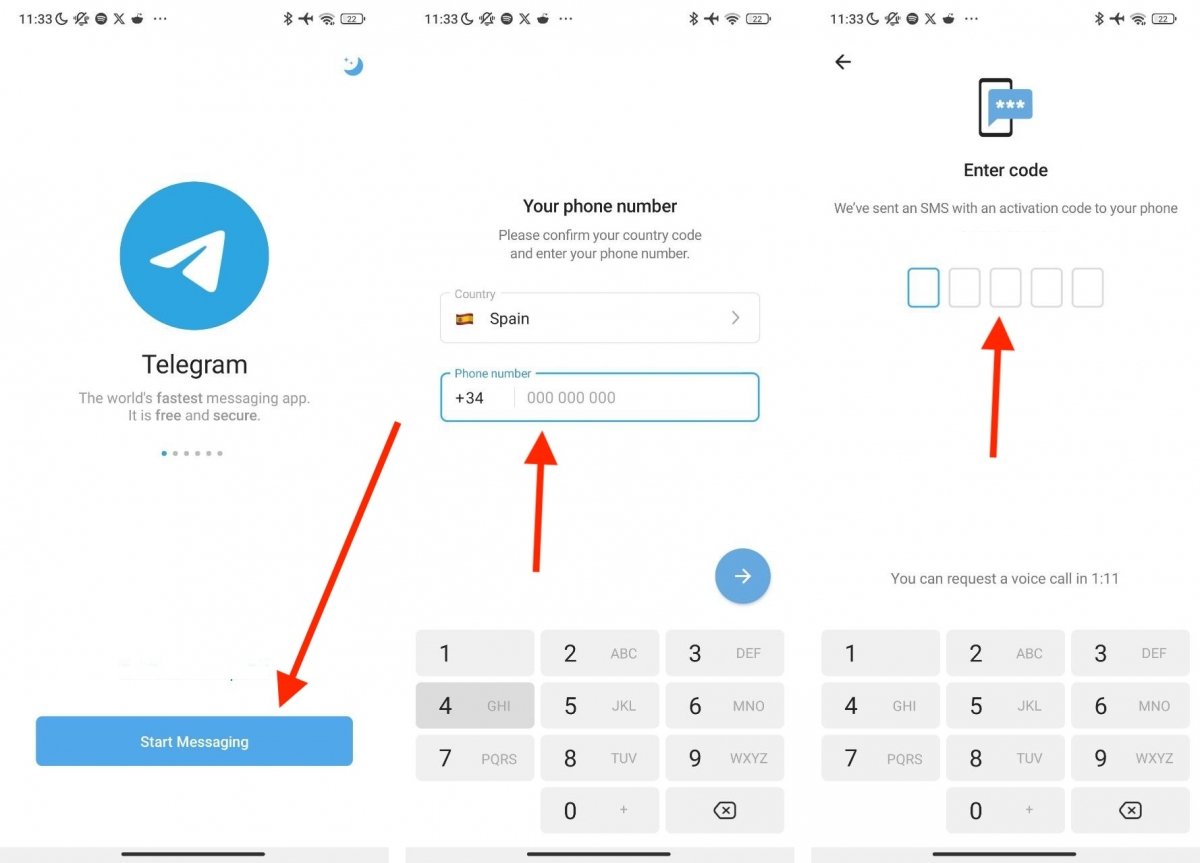 Steps to login or create a Telegram account
Steps to login or create a Telegram account
To start using Telegram, whether you want to log in with your account or create a new one, you must follow these instructions:
- Open the app and tap Start Chatting.
- Tap in the upper text field to enter your country's phone code. You can also select your region with the drop-down menu above.
- Once you have entered your phone number, Telegram will ask you to confirm it.
- Finally, wait to receive the SMS to complete the registration process. If you already have an account you have used on another device, you will get the security code through a Telegram chat.
Every time you access Telegram, you must enter your phone number to receive a code through another device or an SMS.
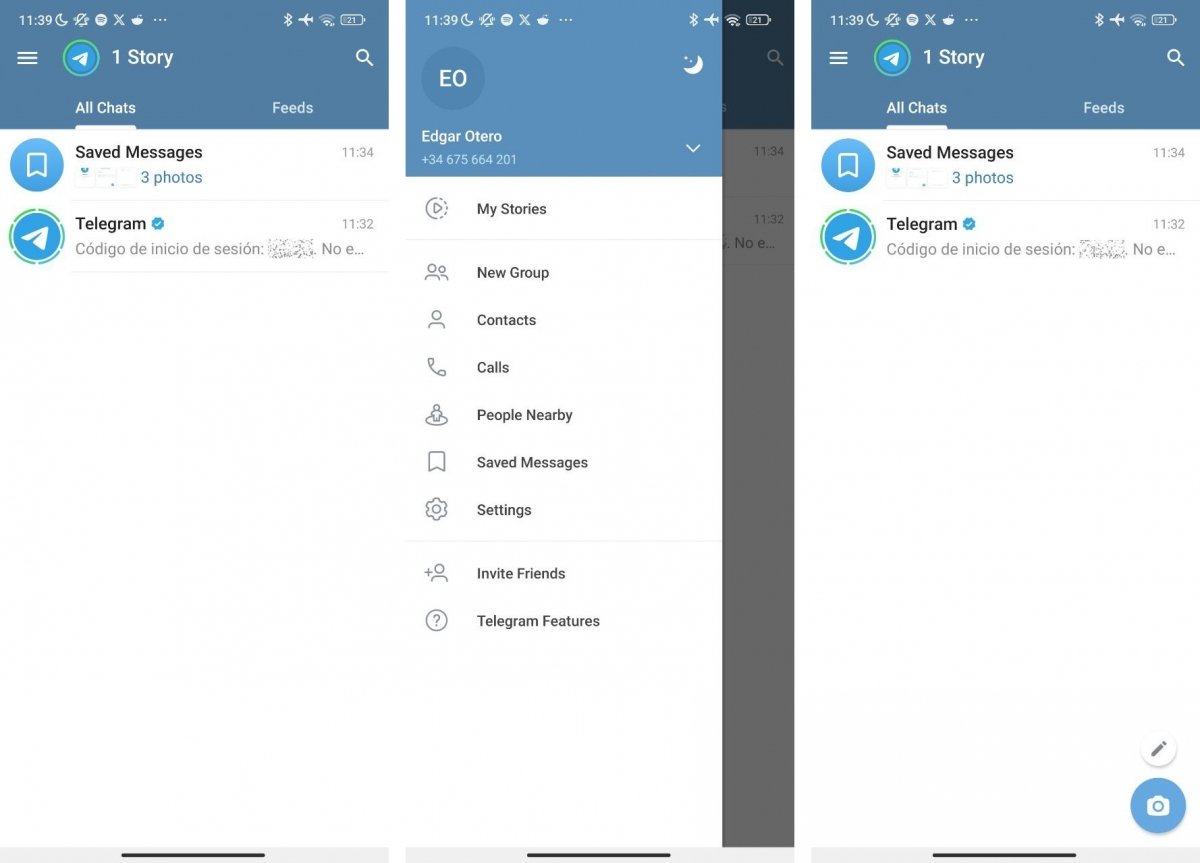 Home screen and menu for Telegram on Android
Home screen and menu for Telegram on Android
Once you have accessed the main screen, these are the first steps we recommend you to take:
- In the central area, you will see all active chats. You may not have any, especially if you have just created your account.
- Tap on the button with the three horizontal lines to open the menu.
- The side menu gives you access to Telegram's main functions. You will be able to, among other things, start a group, call your contacts, see people who are close to you, or enter the settings.
- If you want to start a new conversation, tap on the pencil button in the lower right corner of the screen.
- Now, choose a contact and start talking to them.
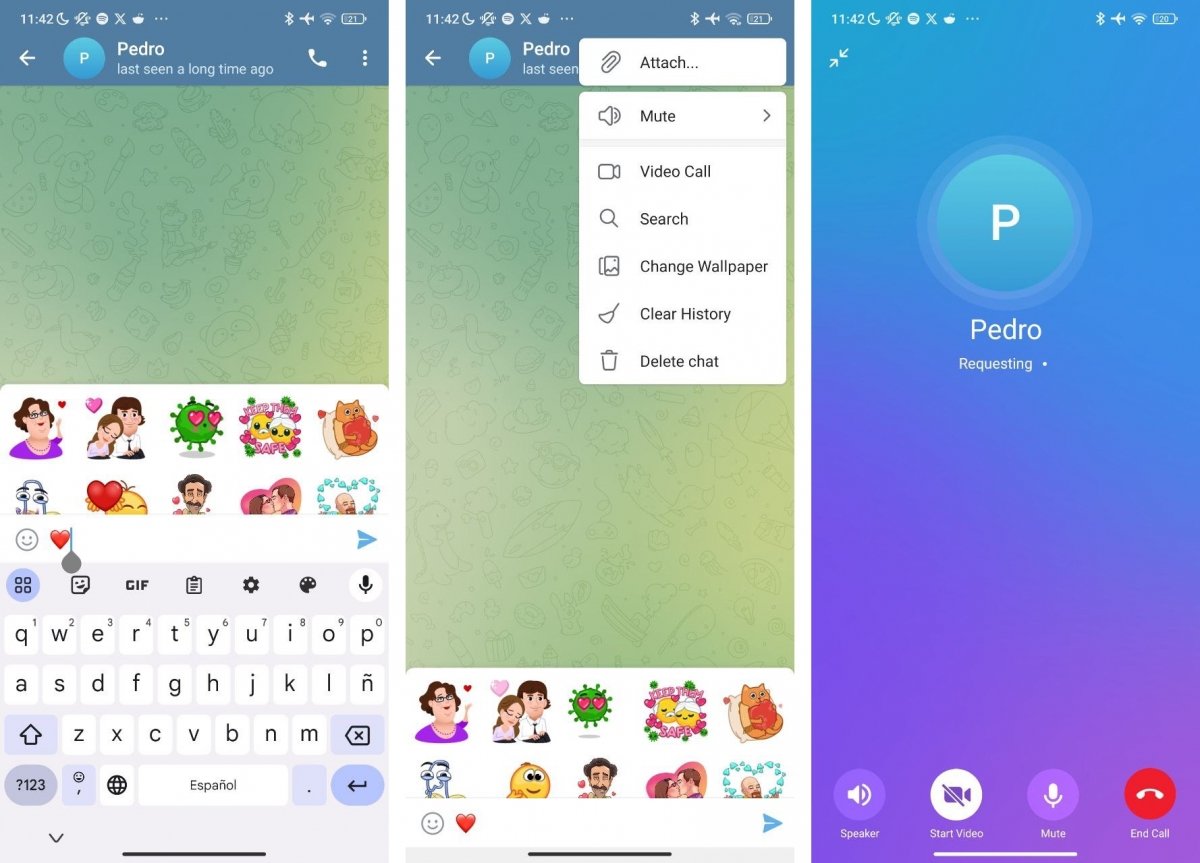 Aspect of a Telegram chat and all options available
Aspect of a Telegram chat and all options available
Once you have a basic understanding of how the platform works, try starting a conversation. Here are some things you can do:
- Besides writing text messages, you can use emojis to express yourself. In the case of Telegram, emojis are usually linked to stickers. They are displayed as a suggestion whenever you add, for example, a heart or a smiley face.
- Although you can access functions such as attaching files from the text field where you type, all the options you might need are in the context menu. From there, you can change the background of the chat, empty it, search for something in it, and much more.
- The contact's name is displayed at the top of the screen. If you tap on it, you can see all their information.
- Finally, remember that you can call and video call your contacts by tapping on the corresponding option in the menu.
Now that you've read this section, you already know how to use Telegram to chat with others. However, this app is full of features, so you may need some time to discover them all.
How to configure Telegram to make the most out of it
Telegram has a lot of settings that will help you get the most out of its service. All of them are located in the Settings section of the app's main menu.
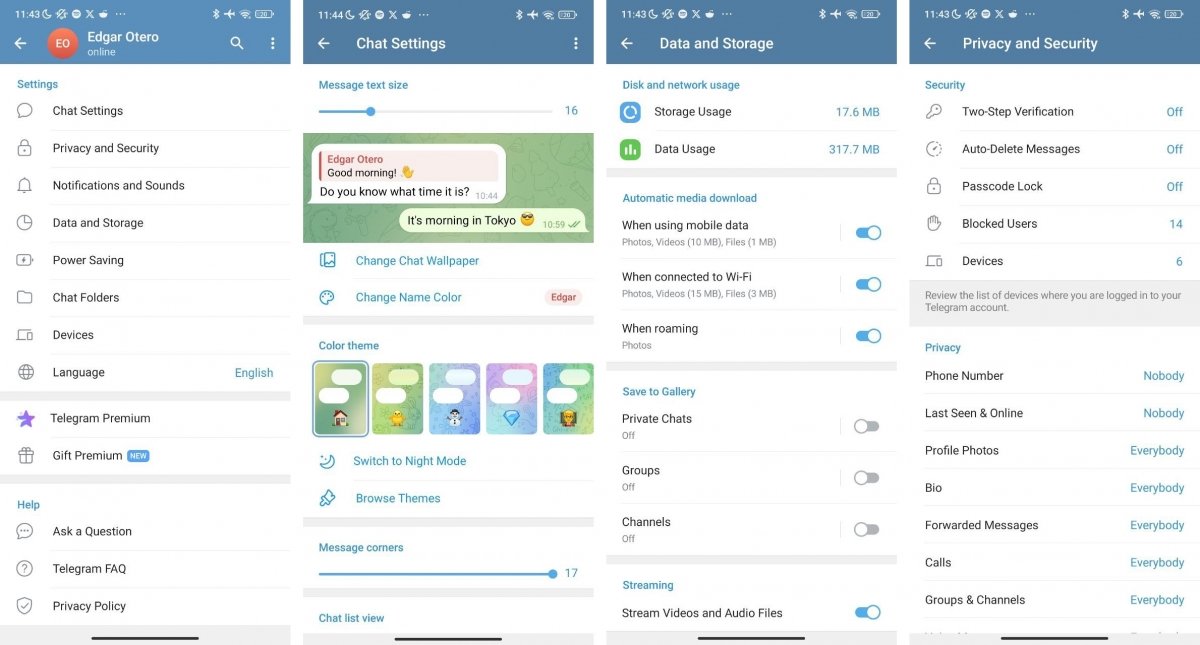 List of Telegram settings and some of the most important sections
List of Telegram settings and some of the most important sections
Here are some features you can customize to tailor your Telegram experience to your needs:
- Chats. Here, you can modify the appearance of individual conversations and groups. You can install themes and change the font size and background.
- Privacy and security. Here, you can improve your privacy by changing the data other users can see about you.
- Notifications and sounds. Change the notification sounds and delete the notifications you do not need.
- Data and storage.
- Energy saving. Reduce the impact of Telegram on your device's battery life.
- Chat folders. Organize your chats as you see fit, creating folders to categorize them.
- Devices. Manage the devices you are logged in to with your account.
- Language. Choose from the long list of languages that Telegram supports and change the automatic translation preferences.
Main features of Telegram: is it secure and private?
In the first section of this guide, we explained the main features of Telegram. We talked about the types of communications it lets you have and how the bots make it a versatile platform. But what about security and privacy?
In this regard, there are several things you should know about Telegram. To begin with, this is a platform with a good reputation. So far, it has not been involved in controversies about data leaks or compromising situations. Beyond its fame, some technical aspects are worth reviewing to understand the degree of privacy it offers:
Telegram's main security features include:
- MTProto Protocol. Telegram uses the MTProto protocol to ensure security, speed, and reliability over weak connections.
- End-to-end encryption in secret chats. Secret chats use end-to-end encryption, leave no traces on Telegram's servers, allow messages to self-destruct, and do not support forwarding. In addition, these chats are not part of the company's cloud and are only accessible from the device that sent them.
- Double-layer encryption. Telegram uses two layers of secure encryption: one for server-client encryption in cloud chats and an additional layer for secret chats that uses client-client encryption.
- Algorithms used. It uses proven algorithms such as 256-bit AES, 2048-bit RSA, and Diffie-Hellman secure key exchange to encrypt all types of data, including text, multimedia, and files.
- Transparency and source code review: Telegram is an open-source platform, meaning anyone can review its source code, protocol, and API, allowing for an independent assessment of its security.
- Non-profit app. This is a non-profit platform, meaning commercial interests do not interfere with its commitment to the security and privacy of users. That is not to say that the company is not opening up new funding avenues, such as Telegram Premium. It must be remembered that maintaining a service of this magnitude is costly and complex.
- Vulnerability Rewards Program. Anyone can earn from $100 to over $100,000 by discovering security vulnerabilities. It also invites those who claim to be able to decipher the encrypted messages to enter a contest to prove it and win $300,000.
Having analyzed all this, we must mention that Telegram does not offer end-to-end encryption by default, unlike other applications, such as WhatsApp or Signal. Users can only end-to-end encrypt their messages in secret chats. Nevertheless, Telegram collects less personal data, especially when compared to WhatsApp.

